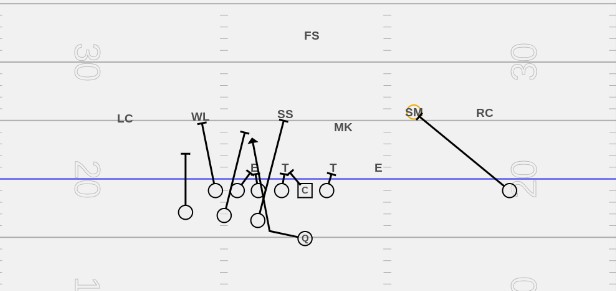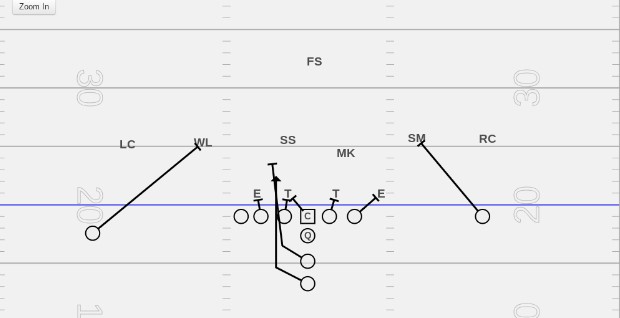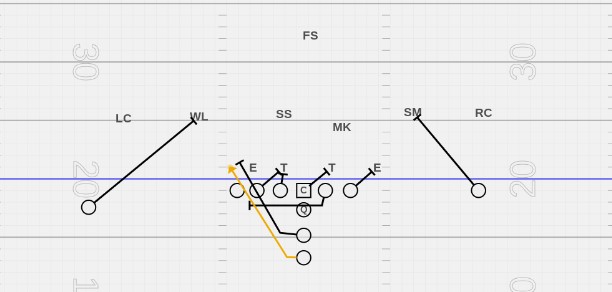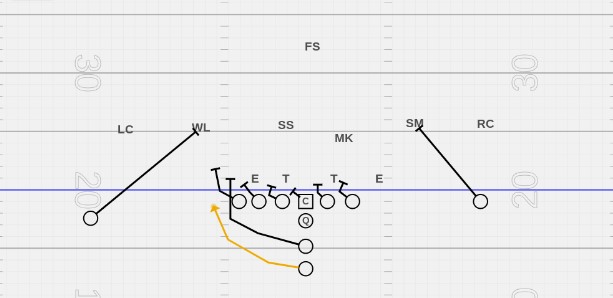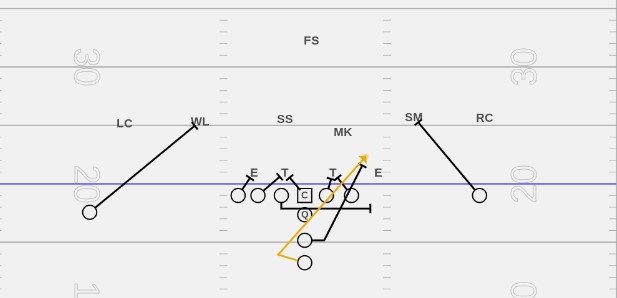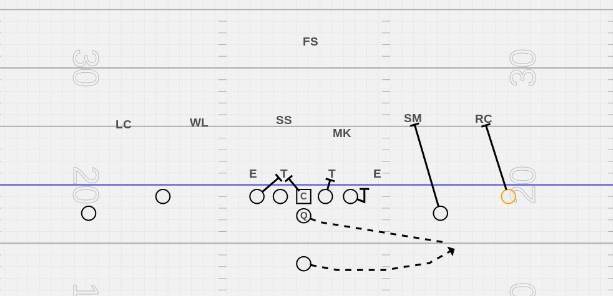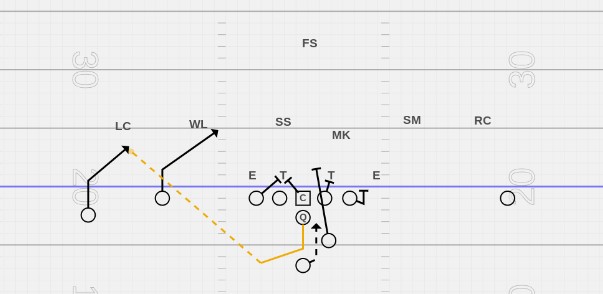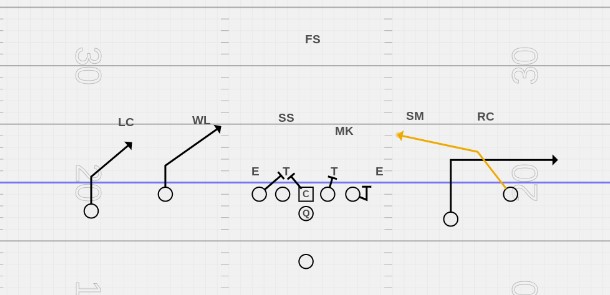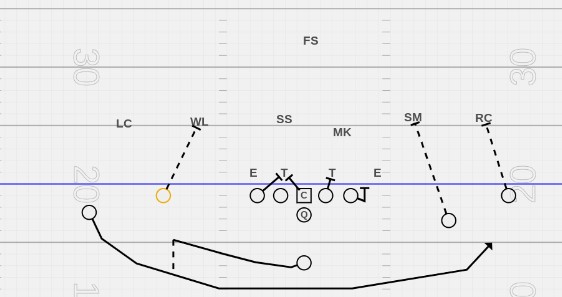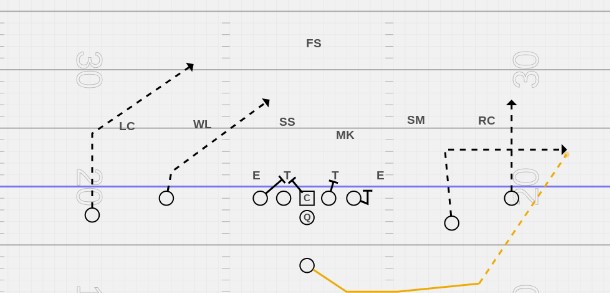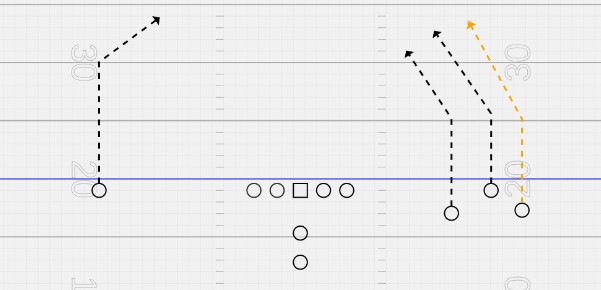No matter how good of football players you have on a team, if you don’t have a competent coach and good football plays, you likely won’t win many games.
On the other hand, there have been plenty of teams with below-average talent but great football plays that win a ton of games. From college football teams to the junior level and all the way to the NFL, having a solid playbook will help football coaches win football games.
As I began coaching my kids over the last several years, I started to get involved in our offensive game-planning and have really enjoyed the deep dive into offensive schemes and game-planning for each opponent.
I wanted to put together this post, outlining some of the top football plays for youth and high school teams. These plays took a ton of repetition to master, but have shown consistent results week in and week out.
All of these plays and concepts can be run out of the same formation. Keeping your formations the same and running the ball carrier from the same formation to different locations really helps keep the defense guessing.
Whether you are running out of the shotgun formation or the wing t offense, these plays can be executed and perfected to help you win games.
There are certain plays that may work better out of an I formation than a shotgun formation, however, you can be successful in both. The pictures below are all out of the classic I formation, but again can be run out of any formation your team runs.
Contents
Top 13 Football Plays
Below is a list of my favorite plays as well as easy-to-see diagrams that you can easily take screenshots of to help test out at practice.
1. Inside running plays
Inside running plays are plays that are run off the offensive guards. These plays are quick hitters and short yardage play. These plays are often used in short-yardage situations trying to get just a few yards.
When your team is on the goal line, or close to a first down, inside running plays can help keep the ball moving down the field.
These plays are often referred to as dive plays or plays in the ‘A’ gap. It’s very important for the offensive line to get a good push off the line of scrimmage in order to get a few yards.
Knowing the snap count gives you a split-second advantage to get off the ball quicker than the defense. The offensive linemen will work together with double team blocks to get a good push, which allows the running backs to get a quick 2-3 yard gain every time.
The I formation may be more desirable for the inside run game vs the shotgun formation.
However, you can move certain players around to gain an advantage and get the same result. Make sure during an inside run you have your tight ends ready to block the defensive end.
He is the main person to crash down and blow this play up for a loss.
2. Power Running plays
View this post on Instagram
Power running plays are mainly off the offensive tackles or tight end. These running plays will often have a pulling guard to get more blockers on one side of the ball.
The ball carrier will aim to run between the tackle and the tight end. The typical play is designed to make 3-4 yards. Power run plays can be the best play in your playbook.
Power plays often have a double-team block on the defensive tackle as well as a pulling guard into the hole leading the way. There is also a designed kick out block on the defensive end.
Power plays are short yardage plays, but if blocked correctly can often lead to big gain yardage and touchdown running plays.
3. Outside running plays
There are two types of outside running plays. You can either run the ball carrier off the tight ends or have the running back run to the sideline or boundary.
The blocking scheme is a little different for both. You can either run outside zone blocking, or you can pull a guard if he’s fast enough to help lead block for the running back.
In the outside zone game you need to make sure your tight end really seals the defensive end to allow the running play to get outside.
Oftentimes when you are trying to run super far outside, you will send a running back or receiver in motion to make sure they are at full speed when they take the hand off.
You will see this motion a lot out of double-wing formation so the running backs can go either direction on the running play.
4. Counter-running play
For all the plays above you should have some sort of counter play which runs the opposite direction. Oftentimes the mesh between the quarterback and running back will happen on the play side of the field.
However sometimes handing the ball off on the backside and having the running back cut back the other way can throw off the linebackers.
These counter football plays are running plays that can really keep the defense honest and add a level of complexity without confusing your team.
A football game is a game of inches. Sometimes getting the linebackers to move just 1 inch in the opposite directions allows your running back the time and space needed to pick up valuable yardage.
View this post on Instagram
5. Screen passing plays
Screen passing plays are a football play to get your athletes out in space and one of the most popular football routes. When you pass the ball outside the tackle box you create one on one matchups that can create big gain yardage.
Screen passing plays should be the first set of passing plays you should install for your team.
These are high percentage passes that should be completed almost all the time. All the plays in your playbook should give you an opportunity to gain yardage.
I know it’s fun throwing the deep route, however a good screen pass can really help set up the deep route.
Screen passing plays can be thrown to the wide receiver, slot receiver, tight end or even the running backs.
They are usually designed to have blockers out in front so once the receiver catches the ball, he has blockers ready to escort him into the end zone.
6. Play action pass
Play action passing formation and really drive a defensive coordinator crazy and can be a great football play.
If you have a really good running back and are having success running the football, then having a good play action pass game is a must.
This means you have a fake handoff to the running back before passing to a wide receiver.
Opening up the football playbook and finding some play action pass plays would really help get your receivers open.
The hardest part about play action passes in the pass protection. Since you want to sell a running play, you need to make sure your linemen don’t go too far downfield.
Unlike the screen game, play action passes take longer to develop. This means you have to make the offensive line protect your quarterback and give him enough time to throw without going past the line of scrimmage.
View this post on Instagram
7. Short passing plays
Every team needs to find a way to get some short passing plays in their playbook. These passing plays can be quick slants, or an out route.
The quarterback throws with a quick 2 or 3 step drop. These plays are meant to come out of the quarterback’s hands fast.
The offensive linemen need to remember not to go downfield during passing plays. For quick passing plays they should not have too much issue being downfield as the ball will usually be thrown fast.
It is very important for the quarterback to understand if the defense is lined up in a zone coverage or man coverage.
A short quick pass into zone coverage can oftentimes lead to interceptions.
One of my favorite offenses to run is a spread offense with good fast receivers. Most people think that a spread offense has to throw the ball deep.
But you can really use these short passing plays to get short yardage and move the ball like running football plays.
8. RPO
RPO stands for Run-Pass-Option. This is where the quarterback either has a pre snap or post snap read to either run the football or pass the football.
Football plays can be complicated for young athletes to digest as they are learning the game. You also need to make sure your offensive linemen know if you’re passing or running so they don’t go downfield.
If you are coaching young athletes they may not be ready for RPO’s. As they get a little older you can introduce this concept and have the quarterback make a pre snap read if he’s going to hand the ball off or throw a pass. As a quarterback enters high school, he may be skilled enough to start making post snap reads.
This means as the play is happening they can choose to hang the football off or pass the ball to a receiver running a route. RPOs are really hard to defend, but require a ton of practice time to get the timing and play read correctly. If we choose to throw the ball we’ll need to make sure the offensive line does not go downfield.
9. Reverse Plays
I don’t personally love having a reverse in my playbook. However it’s often good to have if you play against a defense that likes to over pursue. If read correctly or if the defensive plays are called to defense a reverse, then you could get caught for a big loss.
However, if a defense is not disciplined, then a reverse play could go for huge gains. This play is typically called for a home run and not for a few yards.
Making sure you have the right offensive formations really help make this play successful.
It is a little risky, however, and could either go for a huge loss or a huge gain. Again a reverse should only be used if the defense over-pursues big time and you can catch them in it.
If the defensive line over pursue, we can catch them cheating and beat them in the opposite direction.
10. Halfback pass
These plays might be a play you can use if the defense is overly aggressive. I wouldn’t really call this a trick play, however, it’s starting to go in that direction. These plays can draw in the linebackers to the line of scrimmage opening up the secondary for wide open passes.
The most important aspect of having the running back throw the ball is having a running back that can throw the football. Football plays need to be practiced.
Halfback passes is a play that would need to be practiced a lot in order to get it right. Remember, during these plays the offensive line needs to pass block!
I like to have three receivers to one side in a bunch formation when I call on the running back to throw the ball.
Making sure you are in the right offensive formations is key here. I like my outside receiver to run a corner route to get away from the Safety making the throw less risky.
Whenever my quarterback is not the one throwing the ball, I want to find away to limit the possibility of a mistake.
11. Trick Play
Having a trick play or 2 in your playbook may be worth it. I do not recommend spending too much of your practice time installing crazy plays to trick a defense. Sure trick plays can lead to an easy touchdown pass, however sometimes it’s more hassle than anything.
That said, here is one play you can use to help you score quickly. In modern football these types of plays really help you stay ahead of the defense.
This play requires a little set up. The play before you need to run with only 10 players. Then you act like 1 player has a small injury and gets subbed in for.
The player coming off the side of the field towards his sideline but stays on the field just inside the lines and comes set. One the ball is snapped, he should be WIDE open for a touchdown pass.
It’s important for the offensive coordinator to check with the head coach before calling these plays. Risking a turnover is never good.
One of the reasons I love watching a college football game is you are more likely to see some happen. It’s also fun when you see some defensive plays when a trick play is dialed up to see if they can stop it.
12. Jumbo
Having a jumbo formation can really help you get a few yards when you need it. For these offensive formations you may need to bring in an extra tight end or offensive tackle.
I like to move a big offensive tackle over to the other side of the line of scrimmage and stack my line.
For a jumbo formation, we should be able to double team block on the defensive tackle. If you had a mobile quarterback then you can keep him in the game and have him run behind two offensive tackles and your tight end to get easy quick yardage.
When we run a jumbo package, I like to remove the hand off so we can hit the hole fast.
So I almost run it like a wildcat and have my running back get the snap in a shotgun formation and sprint into the hole behind double teams.
This formation and play call will really make defensive coordinators have to game plan against it, which also takes time out of their weekly prep.
You for sure create a strong side of the field when you do this, that is very hard to defend against. The defensive lineman will get very confused and wonder why the line of scrimmage looks off.
It is also a good idea when you have a jumbo set, you want to have at least one receiver on the outside. When you run this formation a lot you may need to throw a quick pass to the receiver on a flat route to avoid the defense from stacking the box.
13. Hail Mary
Every offense should practice a Hail Mary play. Hopefully you won’t need to use it. However when you are behind 1 score late in the game, the head coach may need to rely on a prayer. You can run this play out of several different offensive formations.
In a Hail Mary pass every receiver runs a fly route or a go route. You will need multiple wide receivers on the field at one time, usually all on one side of the field.
You can also have a tight end on the field during this play as they are usually your taller receivers.
Usually tight ends are not as fast, so you may need better pass protection to get the ball off.
The quarterback will snap the ball, roll out to the side of the field his receivers are on and throw up a prayer.
With all the receivers on one side of the field, the odds of catching a toss up increase drastically.
Usually these passes are in the end zone, so if a receiver catches it, its an automatic touchdown. Remember don’t let your offensive linemen go downfield.
A Hail Mary can also be thrown out of twins formation or even trips formation, where the receivers cross paths in the middle of the field. Again the object here is to throw the ball up to a point where you have a bunch of your receivers.
Make sure your line of scrimmage is protected from the defensive lineman. They will have their ears pinned back and try to sack the quarterback if they know he is dropping back to pass and they don’t have to protect the run.
Conclusion
Once you develop your playbook it’s very important to get as many reps as you can. Each player on the field needs to know their specific job or assignment.
It takes all 11 football players to score a touchdown. Whether it’s a pass play or a run play, it’s going to take all 11 players to move the ball down the field.
A good football coach can use all of these football plays out of different offensive formations.
Whether you are running a spread offense, I formation or out of the pistol formation you will need a combination of these plays to be successful.
Regardless of the plays you run, you will also need to control the line of scrimmage. If a football team controls the line of scrimmage, then they win.
Whether you are playing college football teams, in high school or in the NFL you have to control the line of scrimmage to win.

